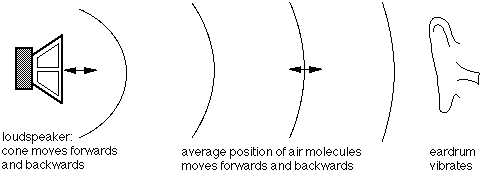
www.phys.unsw.edu.au/music/guitar/
The number of vibrations per second is called the frequency of the sound. The unit of frequency is the Hertz(Hz). The average person can hear sounds ranging in a frequency of about 20 Hz to 20,000 Hz. E is the lowest note on a standard guitar, and has a frequency of 83 Hz.
Sound comes in basically two types. One is called tone and the other is called noise. Tone is sound that repeats at a regular frequency or at similar frequencies. Below is a graph of the sine wave of a 440 Hz tone.

www.howstuffworks.com/guitar2.htm
Noise is the opposite of tone. It is made up of random
frequencies that, when graphed, have no pattern. Examples of noise are the
static on a radio or tv that is not tuned to a station. The picture shown
below is what noise looks like when graphed.

www.howstuffworks.com/guitar2.htm
Musical notes, such as those produced by a guitar, are
tones. They are actually made of just a few tones that sound pleasing to
our ears when played together. When a guitar plays a tone it takes advantage
of what is called harmonics. That is, when one string is played it
rings at multiples of the original tone. In addition, the other strings vibrate
a little as well. All of the frequencies that are created are similar and
blend together to get the distinctive guitar sound. The picture below is
a graph of a 440 Hz frequency blending with an 880 Hz frequency. It is easy
to see the repeated pattern in the graph that distinguishes it from just
noise.


www.howstuffworks.com/guitar4.htm
The overall physics of sound is much more complex than what has been presented
here. However, this page offers the basics of how sound is involved in
the function of the guitar. The following pages will look at how the guitar's
various parts work together to create its familiar sound.